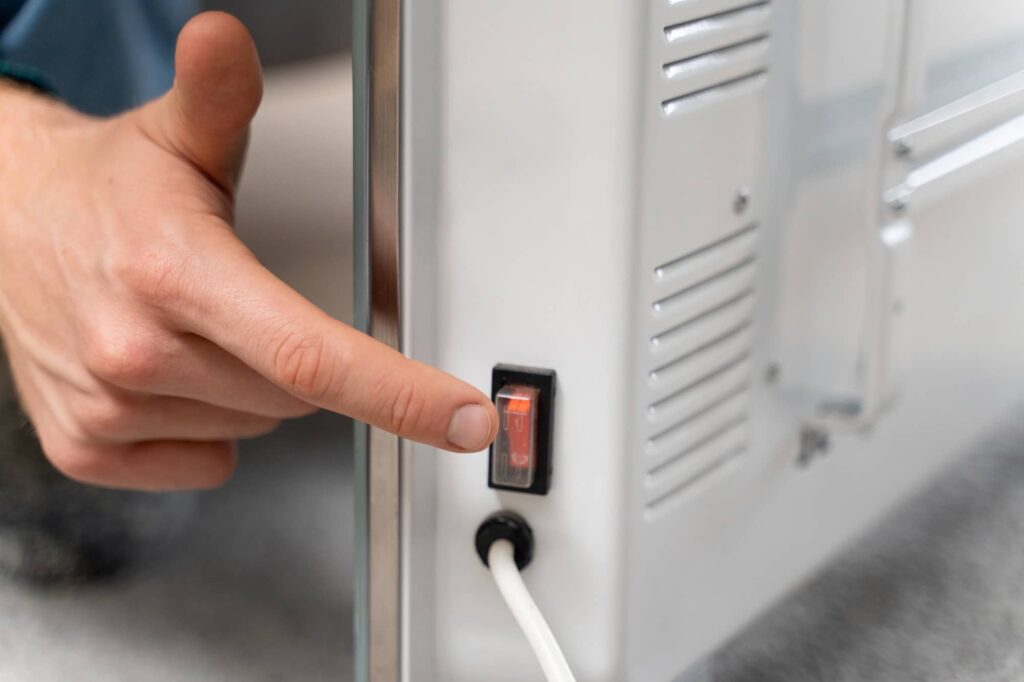An overheat shut-off device is a safety feature that shuts off a portable heater automatically when its components reach an unsafe temperature. This system is comprised of sophisticated temperature sensors, thermal fuses, and circuit breakers designed to prevent the heater from short-circuiting. These units are designed to sense overheating and discontinue power before it creates any damage or danger.
What is an Overheat Shut-Off Mechanism?
The overheat shut-off is a safety feature that automatically engages and de-energizes the entire portable heater should a dangerous internal temperature be detected. This system comprises a series of sophisticated thermal sensors, thermal fuses, and circuit shut-offs that collectively ensure the space heater does not pose a fire risk. Each aids in identifying abnormal heat build-up and stopping the flow of power before damage or danger can result.
Over Temperature and Overheat Protection
Overheat protection is also a very important safety feature that effectively shuts off a portable heater if one or more internal components become too hot. This is not the same as a simple thermostat that controls the temperature of a room. Overheat protection is a safety feature that does exactly what it sounds like – it protects the iron (and other electronics) from overheating by automatically shutting it down if any of the temperature-sensing components fail. It usually employs sensors, including those thermistors in your article, to continuously gauge heat.
The hot box has a built-in shut-off; whenever the inside temperature reaches too high, typically between 130–150°C (266–302°F), the system stops working. This act turns off the heater at once, not letting it produce any more heat and starting to cool off to a safe level. That’s why you frequently hear a clicking sound and notice the power light of the heater goes dim when it heats for a long time or is kept in a confined space. The latter precaution is necessary not only for saving the unit itself from destruction but also, of course, for avoiding fire.
How Overheat Shut-Off Mechanisms Work
- Thermistors: Today, portable heaters come with precise thermistors or heat-sensitive bi-metallic sensors. These sensors are designed to search for and monitor the core temperature of the heater. Thermistors change their resistance value in response to temperature fluctuations; data is wirelessly sent to the heater’s microcontroller. If the internal temperature exceeds a predetermined safety limit, often in the range of 130-150°C, it triggers a sensor to energize a fail-safe switch that stops power to the heater automatically.
- Thermal Fuses: Provide additional safety as a cut-off system to prevent overheating due to abnormal temperatures. These fuses are heat-sensitive and designed to melt or break when they reach a certain temperature – usually between 100°C and 200°C, depending on the model of heater. This physical opening of the circuit is a one-time event, which disconnects the source of heat and shuts down the heating source until a service technician can replace the fuse.
- Automatic Reset Mechanisms: For added safety, there are newer high-end heaters equipped with self-resetting thermal switches – they turn off the heater if it continues heating beyond a safe temperature and turn it back on once it’s cooled down. These are generally the type of devices that contain bi-metal discs, which snap when they cool. On the other hand, manual reset models require the user to manually reset them by pushing a button. They are thus a preferred method for the user to be aware of and alerted to overheating before reuse.
Importance of Overheat Shut-Off Mechanisms
- Prevent Fires: Most electrical fires are started due to overheating and the transfer of the heat to a combustible material. The overheat shut-off system is the heater’s first line of defense, signifying that it will automatically cut power if it reaches a temperature beyond the acceptable level- thus preventing a potential fire hazard.
- Preservation of Property: Overheating may cause damage to your household items, such as carpets, curtains, and wooden furniture. The shut-off feature automatically turns off the heater if it gets too hot, preventing damage to your valuable property.
- Energy Saving: A heater that overheats and shuts down constantly wastes energy and raises the bill. The overheat shut-off feature is automatically activated to prevent the heater from running if its heat exchanger becomes too hot; it won’t run again until the overheat condition is removed. Accidental tip-over safety shut-off; Heavy-duty ignitor; Properly sized modulating gas burner.
- Longer Product Life: Heat can kill heaters, wires, and PCBs. The overheat mechanism prevents the heater from getting too hot, which in turn protects the heater from damaging any of its integral pieces, ultimately keeping you safe and the heater in proper working condition through its life.
- User Confidence and Peace of Mind: When a heater has added safety features built in, it gives users confidence, and they can feel more at ease about using it. It is especially important if the heaters are used overnight or in an unattended area, so you do not have to worry if the air is circulating, the safety is working, or that it will automatically shut off.
Do Heaters Turn Off Automatically?
Additional Safety Considerations for Portable Heaters
Although overheat turn-off devices go a long way in keeping things safe when it comes to heaters, there are things that all users can do to avoid accidents:
Heaters and Flammables Do Not Mix: Always place the heater at least three feet away from flammable materials, such as drapes, paper, and bedding.
For Use on Stable Surfaces: Place heaters on stable, level, flat, non-skid surfaces to avoid tip-over. Opt for appliances with anti-tip shut-off for your safety.
Dust and Debris Build-up: Air vents and filters can become clogged with dust and debris, limiting the performance of your heater. Clean the unit regularly to ensure optimal operation and safety.
Buy Certified Products: Choose space heaters that have been tested and certified by a nationally recognized testing laboratory (such as UL, ETL, or CSA). They manufacture the most portable space heaters, often equipped with a range of safety features, including overheat protection, tip-over switches, and cool-touch housings.
Conclusion
The overheat shut-off function is one of the most critical features in portable heating, reflecting the high quality, intelligent design, and unparalleled engineering quality. This functionality helps protect property and save businesses and homes from potentially catastrophic fires while also promoting energy efficiency and longer product life.
In addition to responsible use and common maintenance, the overheat shut-off technology ensures that portable heaters are a safe and reliable source of warmth. While selecting a portable heater has the advantage of being able to move the unit to wherever you need it most, many models come with a full safety system to keep you warm in style.

